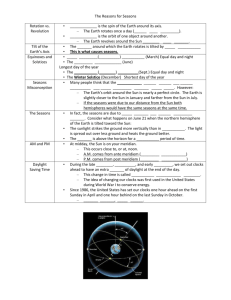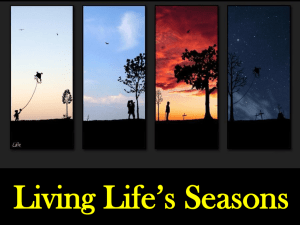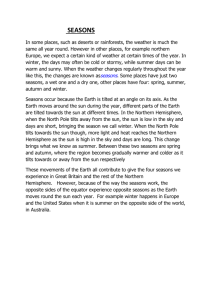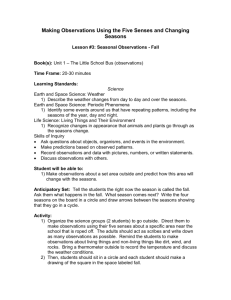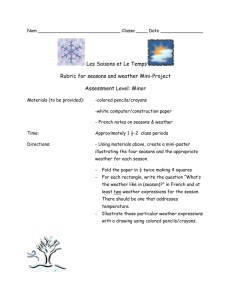Lesson Plan M.Borodina
advertisement
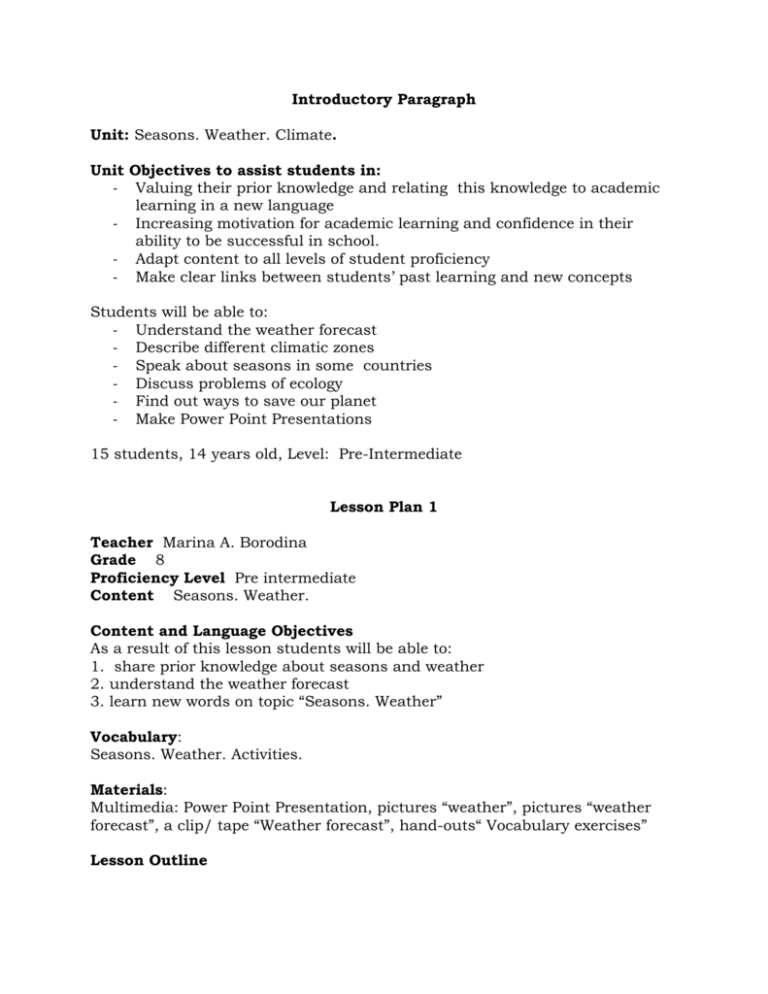
Introductory Paragraph Unit: Seasons. Weather. Climate. Unit Objectives to assist students in: - Valuing their prior knowledge and relating this knowledge to academic learning in a new language - Increasing motivation for academic learning and confidence in their ability to be successful in school. - Adapt content to all levels of student proficiency - Make clear links between students’ past learning and new concepts Students will be able to: - Understand the weather forecast - Describe different climatic zones - Speak about seasons in some countries - Discuss problems of ecology - Find out ways to save our planet - Make Power Point Presentations 15 students, 14 years old, Level: Pre-Intermediate Lesson Plan 1 Teacher Marina A. Borodina Grade 8 Proficiency Level Pre intermediate Content Seasons. Weather. Content and Language Objectives As a result of this lesson students will be able to: 1. share prior knowledge about seasons and weather 2. understand the weather forecast 3. learn new words on topic “Seasons. Weather” Vocabulary: Seasons. Weather. Activities. Materials: Multimedia: Power Point Presentation, pictures “weather”, pictures “weather forecast”, a clip/ tape “Weather forecast”, hand-outs“ Vocabulary exercises” Lesson Outline Content: I want students to review old and learn new vocabulary on the topic “Seasons. Weather” Teaching Phase Sequence Warm-up Activity Brainstorming: Students are divided into 4 groups (according to their birthdays): Winter, Spring, Summer, Autumn There are pictures with different weather conditions on the board. Each group chooses their pictures and writes down as many words as possible connected with their seasons. Transition After group work students have a list of words they need for the next work. Now they are grouped into other groups so that each group consists of any season. Activities Activity 1 Graphic organizer / mind map/ table / diagram Activity 2 Listening to the weather forecast. Activity 3 Vocabulary exercises (match new words with their definition) Differentiated Instruction Starting Up. Students will be given the option to work with other students to make a vocabulary list. Beginning. To extend their knowledge students will be grouped in other groups. Developing. They share their words and create a graphic organizer / mind map/ table / diagram Expanding. Students listen to the weather forecast and write down new words (Students who are at the beginning level have a printed text on their tables). After listening to the text students pair up and work with dictionaries looking up the meanings of new words. Later all students get texts with the forecast, they answer some questions. Bridging. To learn the new vocabulary students do some vocabulary exercises. Homework Make up your own weather forecast (according to the picture) Lesson Plan 2 Teacher Marina A. Borodina Grade 8 Proficiency Level Pre intermediate Content Climatic zones Content and Language Objectives As a result of this lesson students will be able to: 1. Name and describe different climatic zones 2. Read maps 3. Take notes watching a short film (Cornell-notes) 4. Express their opinion taking part in the discussion Vocabulary: climatic zones Materials: The World Map, BBC film “Planet Earth”, Cornell notes Lesson Outline Content: I want students to learn to discuss some questions about climatic zones Teaching Phase Sequence Warm-up Activity Students search the words in the Word Box Transition A flight over the planet Earth. Activities Activity 1 Reading geographical maps. Activity 2 Watching the BBC film about climatic zones and filling in the Cornell-notes. Activity 3 Discussion “Pilot – Copilot – Copilot” Differentiated Instruction Starting Up. To involve students in the lesson, they are asked to find English words in the Word Box. Beginning Using the GOOGLE program we make a flight over the planet Earth. Students name continents and countries they can see in the flight. Developing. Using the maps students answer the questions about the continents and countries. They compare temperatures, suggest what plants and animals can be in different continents and countries. Expanding. Students are supposed to watch the BBC film about climatic zones and fill in Cornell-notes. Bridging. Using the Cornell-notes students take part in discussion “PilotCopilot-Copilot” Homework Students should write advice for tourists who are going to visit different places of the world (each student writes for a particular country): Seasons, weather, clothes to take with, possible activities Lesson Plan 3 Teacher Marina A. Borodina Grade 8 Proficiency Level Pre intermediate Content Australia Needs Extra Season Content and Language Objectives As a result of this lesson students will be able to: 1. Speak about seasons in Australia 2. Learning through cooperative learning task. Jig-saw reading 3. Ask questions to the text Vocabulary: Seasons in Australia Materials: A script “News of Australia”, hand-outs Table, Reading task Lesson Outline Content: I want students focus on different seasonal problems. Teaching Phase Sequence Warm-up Activity A video-clip: A short news of Australia. Transition T-list: What are the best and worst things about having 6 seasons? Activities Activity 1 Before reading True/false: Read the headline. Guess if statements are true (T) or false (F). Activity 2 Jig-saw reading Activity 3 Each group should think one more season which is very useful for our country Differentiated Instruction Starting Up. There is a new information for students about seasons in Australia. It seems that four seasons are not enough for Australia. There are some suggestions about two more seasons in the country: sprummer and sprinter. Beginning. Students complete the table with their partner(s). Later they should change partners and share what they heard. Developing. Student do before-reading task: true or false Expanding. Working in groups students do jig-saw reading “Six seasons in Australia”. Bridging. According to the text, students should make up a new season for Russia. Homework Make the poster about the seasons in Russia / the USA / the UK (pair work) Lesson Plan 4 Teacher Marina A. Borodina Grade 8 Proficiency Level Pre intermediate Content Climate Change Content and Language Objectives As a result of this lesson students will be able to: 1. Understand how important it is to save our planet for the future 2. Listen to the song for main ideas 3. Discuss the problems of ecology in the world 4. Find out ways what can people do to slow down climate change Vocabulary: Ecology Materials: A song “Road to Hell” by Chris Rea, hand-outs “Outcomes of global warming”, Power Point Presentation “Global Warming” Lesson Outline Content: I want students to connect changing of climate with environmental problems Teaching Phase Sequence Warm-up Activity Students listen to the song “Road to Hell” by Chris Rea. Transition Students answer the question about the problems given in the song. Activities Activity 1 Power Point Presentation Outcomes of global warming. Students in pairs should rank the outcomes of global warming. Activity 2 Quick Debate. Activity 3 Think-Pair-Share. Differentiated Instruction Starting Up. Students listen to the song and try to catch the main ideas of the song. Beginning. Students point out the problems given in the song. Developing. Students watch a presentation “Global Warming”. After that they rank the outcomes of global warming. Expanding. Students A think climate change is not a problem; students B think climate change is the most serious problem in the world today. Change the partners. Bridging. Students think silently about a question “What people can do to slow down climate change”. In some minutes students pair up and exchange thoughts. Later the pairs share their responses with the whole group. Homework Power Point Presentation (Slides: Country. Climate. Plant and animal world. Popular activities in different seasons. Student’s advise: Best season to visit (Why) Lesson Plan 5 Teacher Marina A. Borodina Grade 8 Proficiency Level Pre intermediate Content Seasons. Weather. Climate. Demonstrating Power Point Presentations Content and Language Objectives As a result of this lesson students will be able to: 1. Revise vocabulary on the topic “Seasons. Weather. Climate.” 2. Make presentations on the topic Vocabulary: Words and phrases for giving an oral presentation Materials: Computer, Projector, Power Point Presentations, prizes Lesson Outline Content: I want my students to learn to give a presentation Teaching Phase Sequence Warm-up Activity Gallery Walk Transition Authentic task. Activities Activity 1 Students give presentation in oral form using their Power Point Presentations. Differentiated Instruction Starting Up. Students watch the posters “Seasons in different countries” made earlier. They can ask questions, give comments what they see. Beginning. The tourist agency of our town gives students an opportunity to take part in a contest “The best season to visit”. The manager of the agency makes an announcement about the contest and asks students to show their presentation. Expanding. Students give presentation in oral form using their Power Point Presentations. Bridging. The manager of the Tourist Agency gives prizes to students for their research work.

